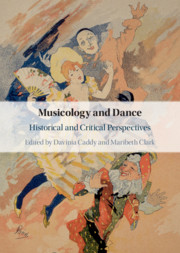Book contents
- Musicology and Dance
- Musicology and Dance
- Copyright page
- Contents
- Figures
- Tables
- Music Examples
- Contributors
- Acknowledgements
- Introduction
- Part I Conceptual Studies
- Part II Case Histories
- Chapter 5 The ‘Splendid and Shameful Art’: Dancing in and around the Wagnerian Gesamtkunstwerk
- Chapter 6 Hymnody, Dance and the Sacred in the Illustrated Song
- Chapter 7 Pavanes and Passepieds in the Age of the Cancan
- Part III Critical Readings
- Select Bibliography
- Index
Chapter 5 - The ‘Splendid and Shameful Art’: Dancing in and around the Wagnerian Gesamtkunstwerk
from Part II - Case Histories
Published online by Cambridge University Press: 09 September 2020
- Musicology and Dance
- Musicology and Dance
- Copyright page
- Contents
- Figures
- Tables
- Music Examples
- Contributors
- Acknowledgements
- Introduction
- Part I Conceptual Studies
- Part II Case Histories
- Chapter 5 The ‘Splendid and Shameful Art’: Dancing in and around the Wagnerian Gesamtkunstwerk
- Chapter 6 Hymnody, Dance and the Sacred in the Illustrated Song
- Chapter 7 Pavanes and Passepieds in the Age of the Cancan
- Part III Critical Readings
- Select Bibliography
- Index
Summary
This chapter by Thomas Grey presents a focused yet far-reaching account of the significance of dance to Richard Wagner. First, it explores how Wagner theorized the roles of dance, music and text in his ‘total artwork’; then it considers historical practice – examples of the actual dances (and also what the author calls the ‘sublimated choreography’) in several Wagnerian music dramas, especially Tannhäuser, with its infamous Venusberg ‘Bacchanal’. Wagner’s feelings towards dance were double-edged. On the one hand, the composer acknowledged the importance of movement and gesture in the creation of his ideal artwork. Indeed, as Grey suggests, Wagner sought to play up the two, emphasizing the role of the erotic, sexualized body onstage. On the other hand, Wagner liked to ridicule contemporary ballet. But, to Wagner, ballet’s problematic status did not relate to its explicitly bodily and human aspects. Instead, it was the genre’s association with an institutional context – ballet as produced and consumed at the Paris Opéra – that troubled the composer.
- Type
- Chapter
- Information
- Musicology and DanceHistorical and Critical Perspectives, pp. 121 - 150Publisher: Cambridge University PressPrint publication year: 2020

